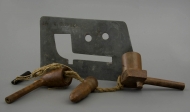Standardization of the briar pipe
May 2007

When we talk about modern wooden pipes made from briar wood, it seems like a twentieth-century product. Those who do more research, however, will discover that also in the second half of the nineteenth century huge numbers of briars left the factories in Saint-Claude and other places. The artifact shown here proves that a great standardized production of pipes already took place around 1900. After the pipe shape had been designed, a mould plate was made in zinc, which was used to set up the machine. This was also used as a control during production to ensure standardization. A turned pipe had to fit exactly in the metal gap. The two circular holes were used to control the stem diameter. Stringed together are two stages of the pipe and a plug to even check the inner bowldiameter. Finally, there is a para rubber mouthpiece that was specifically designed for this pipe. Thanks to a miraculous coincidence, several copies of such plates, or even complete sets, have been preserved that give us an idea of the working method in the factory but also of the shape development within the high degree of standardization. The shape shown, a Dublin bowl with a heel, was originally a clay pipe that was often executed in meerschaum at the end of the nineteenth century. It is remarkable that examples of this rather popular pipe shape executed in briar are hardly preserved. They were literally burnt by the smokers.
Amsterdam Pipe Museum APM 18.677
Archive object of month